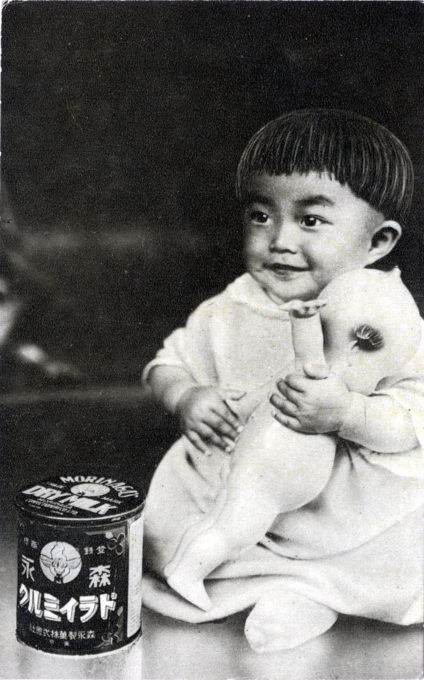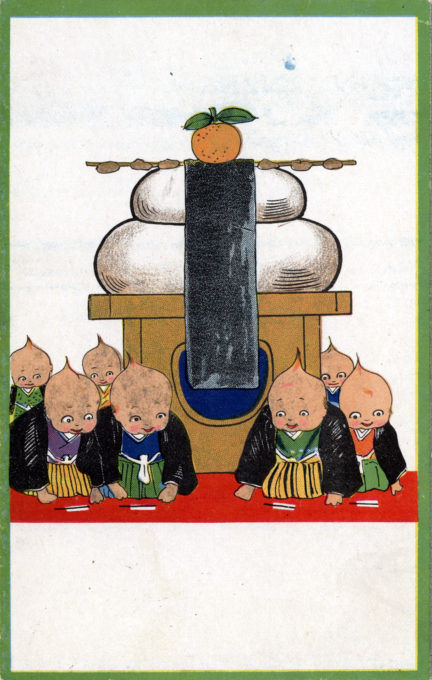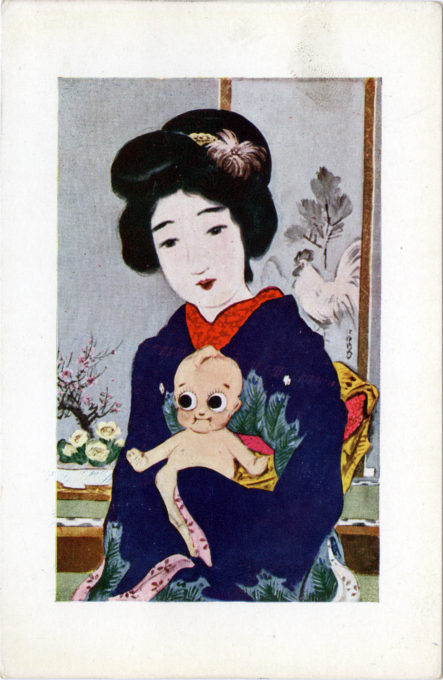With winsome impish smile
The Kewpie Dolls beguile
All little folks (and “grown ups” blue)
Whose hearts they’ll win and keep them too
‘Tis said when cross folks learn the art
Of smiling Kewpie-like by heart
They give that little smile away
A million times or more each day.
– From a Kaufman’s Department Store (Pittsburgh, PA) advertisement for Kewpie Dolls, 1913

Morinaga Dry Milk & Kewpie Doll, c. 1920. Morinaga was one of a number early 20th-century Japanese companies that licensed the Kewpie character for branding purposes. “Kewpie Mayonnaise” is still sold today, produced by Kewpie K.K., with a Kewpie doll logo.
“Rose O’Neill was a glamorous and wealthy artist in her time, and the Kewpies became her biggest success, used in advertisements and spun off into merchandise of all sorts, most notably the Kewpie Dolls, a sales phenomenon in the early twentieth century. (They were considered so important to American pop culture that a Kewpie Doll was among the artifacts of our civilization sealed in a time capsule buried at the famous 1939 New York World’s Fair.)
“Ironically, Kewpie Dolls are largely forgotten in America today – but never in Japan where, in 1926, they were first licensed to introduce mayonnaise to the Japanese market by a company today known as Kewpie Kabushiki Kaisha, one of Japan’s largest food corporations that first began manufacturing food products in 1919 as Shokuhin Kogyo Co. [Kewpie K.K. still sells its Kewpie mayonnaise today, in plastic squeeze bottles adornedwith a Kewpie doll logo first produced in 1958.]”
– Neon Genesis Evangelion: Shinji Ikari Raising Project Volume 1, by Osamu Takahashi, 2014
“When asked how she came to invent Kewpies, Rose O’Neill recalled, ‘The idea grew from a baby brother when I was a little girl. I made drawings of him while I played with him. All his little looks and gestures came out later in the Kewpie.’ She further expanded:
‘In illustrating love stories I had a way of making decorative head and tail pieces with Cupids. Edward Bok of the Ladies’ Home Journal cut out a number of these and sent them to me. He asked me if I could make a series of the little creatures and said that he would find someone to make accompanying verses. I replied that I would make the verses up myself and wrote him an illustrated letter in which I created the character of the Kewpie. I invented the name for little Cupid, spelling it with a K because it seemed funnier. I thought about the Kewpies so much that I had a dream about them where they were all doing acrobatic pranks on the coverlet of my bed.’
“Kewpies first appeared in the 1909 Christmas issue of The Ladies Home Journal and appeared in other magazines including Woman’s Home Companion and Good Housekeeping. In a 1912 edition of Woman’s Home Companion, paper doll cutouts of Kewpies were included. These were so popular that Rose, ever the business woman, decided to expand on the idea and create a three-dimensional version of the popular character.”
– Kewpie Dolls, Mortal Journey, 2010



